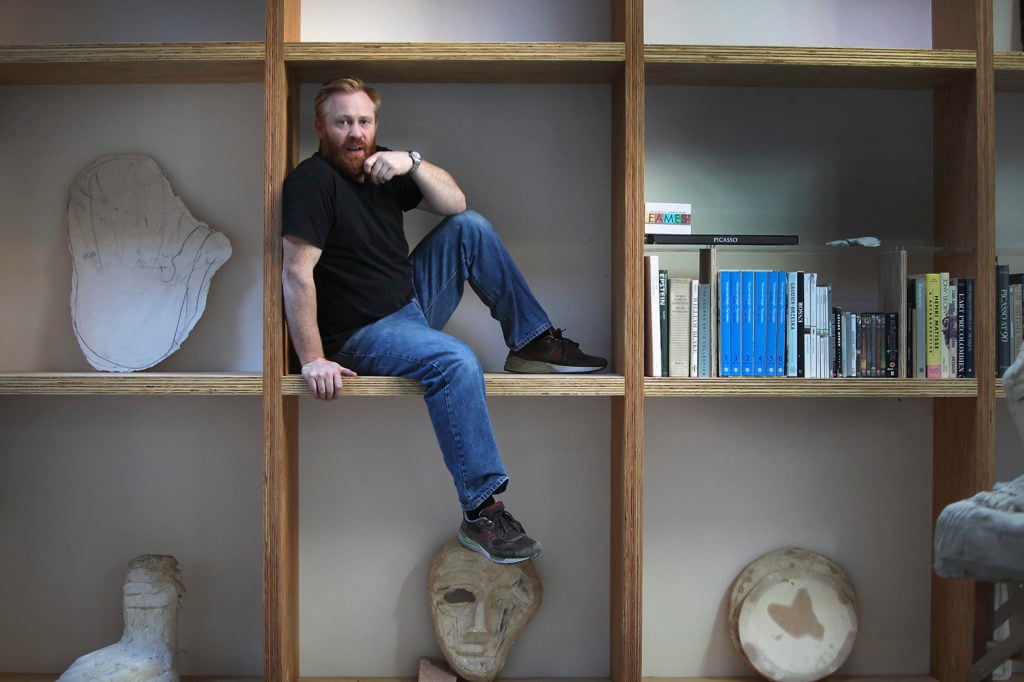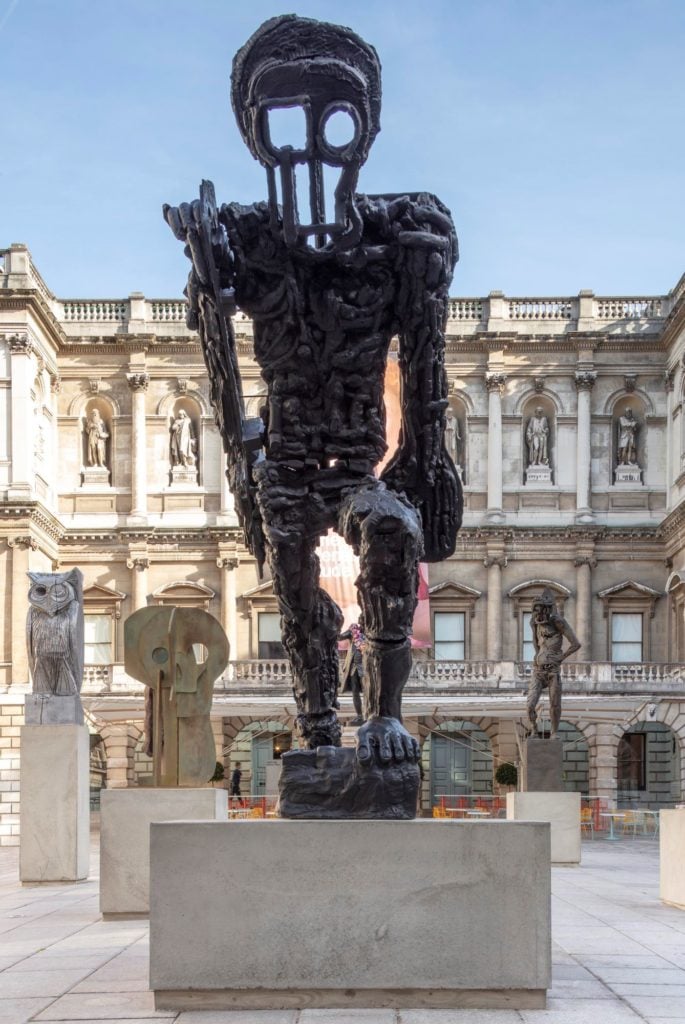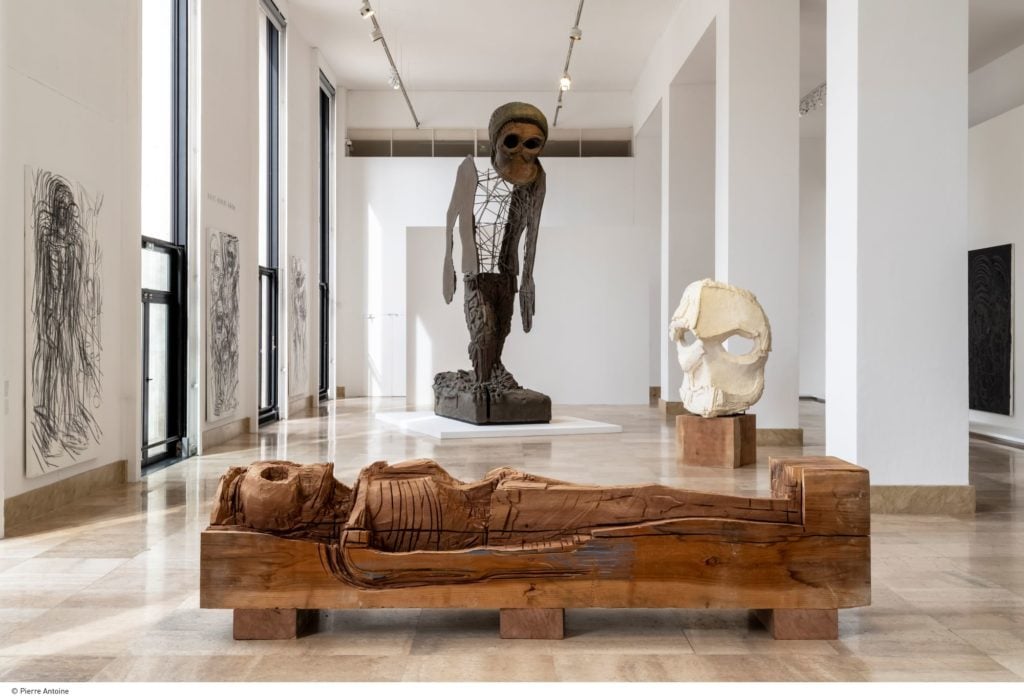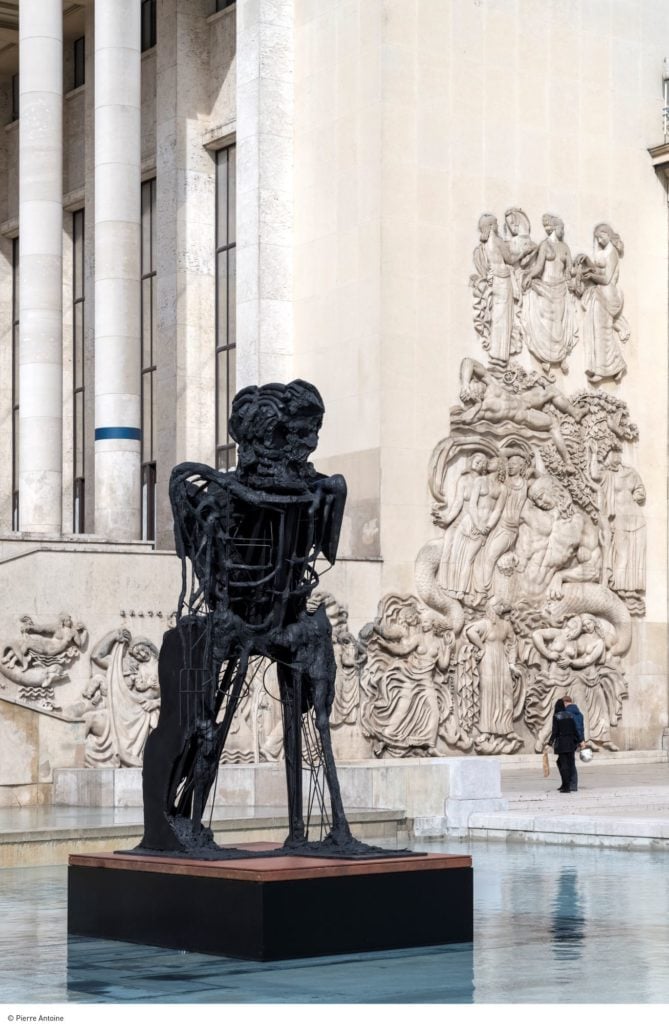People
‘Sculpture Is Dying, If Not Dead’: Artist Thomas Houseago on the Struggle to Make Big, Edgy, Public Art
With shows in Paris and London, the Los Angeles-based artist talks Trump, Brad Pitt, and the "brutal economics" of the art market.

With shows in Paris and London, the Los Angeles-based artist talks Trump, Brad Pitt, and the "brutal economics" of the art market.

Javier Pes

The Los Angeles-based sculptor Thomas Houseago is midway through a grand tour of Europe with his partner, the art therapist and photographer Muna El Fituri. They’ve already been to Venice (where they were shadowed by grumpy paparazzi eager to catch them with their friend Brad Pitt) and Paris, and now they’re in London for Houseago’s exhibition in the courtyard of the Royal Academy.
Houseago—who was born in Leeds in the north of England in 1972 and studied at Central Saint Martins before heading west to LA in 2003—is the first non-Academician to be invited to fill the RA courtyard during its popular summer show. It is a strenuous lap of honor for Houseago, who in March opened a major survey at the prestigious Musée d’Art Moderne de la Ville de Paris.
Housego could be forgiven for looking fatigued, but he seems full of energy. He is made of “Northern indestructible fibre,” Muna says. We met at the RA to talk about the sculptor’s fantasies about Donald Trump, how his friend Brad Pitt sees the art world, and why he wishes David Hockney was the “gay dad” he never had.

Thomas Housego’s Annenberg Courtyard installation, Royal Academy of Arts, 2019. Copyright the artist. Photography by Lucy Dawkins.
You’ve said that monumental sculptures like your works in the RA courtyard aren’t wanted. Qatar buys big works and Art Basel Unlimited was full of them.
If you really look at social space, architectural folly has taken over. It’s sculptural but it’s not sculpture. It has a gift store and toilets and all of that. Sculpture makes a claim for pointless, symbolic space. It’s useless. Sculpture in the way I think of it is disappearing. Sculpture is dying, if not already dead. People think I make money on my big sculptures. I lose money on the big stuff. But I am completely obsessed with the interaction with the public.
With your Paris museum show, “Almost Human,” and the RA guest spot, it looks as if you have got it made as a mid-career artist. Is that not the case?
No! Sculptors are always on the edge of catastrophe. You put all the money back into the work. Painters make profits. The market works for them. Sculpture is impossible—to ship it, to store it, to make it. Maybe five or ten years ago there was a window when it was “woo-hoo!” But now we are moving the other way. The economics of art making are very brutal. No one wants that sculpture out in the [RA] courtyard. Let’s have six monstrous sculptures that are hard to move, so people can go “what the..?!” Even the galleries don’t really want it. I have to fight for it. I’m really close to Paul McCarthy, all the big sculptors, and trust me, it’s like we’re constantly on the edge of catastrophe.
So how did the RA invitation come about?
I have become close to David Hockney. Muna really pushed me to go over [to the Hollywood Hills], and pay my respects. I had a complicated relationship with being from England and from the North. He’s from Bradford and I’m from Leeds [nearby]. Within two seconds he was like my lost father, the gay dad I should have had. Through him I was able to look at England differently. He’s a Royal Academician, he’s from the North, he is in LA, and he manages it in a wonderfully elegant way.
There was a 20-year-old in me that said [about showing at the RA]: “Absolutely no way!” But as I thought about it, anybody can apply and get their work included. I’m weirdly applying from LA to become English again. It is still fraught for me. The day we installed, I didn’t sleep for two or three nights. The RA was where good artists went. I never saw myself as a good artist. I was a bad artist. I couldn’t draw. Everything was highly emotional. I would use art to sublimate my demons.

Thomas Houseago “Almost Human,” Paris. Photograph by Pierre Antoine, courtesy of Xavier Hufkens.
If London was a challenge, what did it feel like to do a big show in Paris? The French don’t take any prisoners, as Jeff Koons and Paul McCarthy learned recently.
Oh my gosh! It’s brutal. Paris was its own intense challenge, but I always felt the French understood my work because of their history of sculpture: Brancusi, Rodin, Carpeaux. I like that hardcoreness. It is “yea” or “nay.” There is a real, gauchiste, up-the-people, fuck-the-bourgeoisie thing, and there is also a real right-wing tradition. I think I was able to handle both points in the show. But it was terrifying.
[Striding Figure II (Ghost) is included in the show and] there was something about the yellow-vest movement, and the anger with the bourgeoisie that in a weird way meant they got behind that sculpture. They felt it spoke to them. It is not a self-congratulatory luxury item. It is a zombie sculpture. It’s about the body breaking down and falling apart. It looks almost burnt. They didn’t feel patronized by it in a way that a big, superstar artist with a big, shiny thing might. I wasn’t turning up in Paris and saying: “Hey! Everything is good.”
You are happy to Instagram works by Modern masters: Matisse’s Backs, Henry Moore’s casts at the Art Gallery of Ontario, an Eduardo Chillida sculpture in Barcelona. There’s no sense of wanting to murder your forefathers. Would you say you’ve mellowed?
I didn’t come to [sculpture] to be the best and beat people. I came to it as a zone of immense political, emotional, and intellectual wealth and safety. Any artist that had made a body of work that I felt was nourishing, I was thankful that it was there.
I didn’t feel like I wanted to destroy anything. [Growing up] I was seeing a society that was losing its connection to art and losing its connection to creativity. I still see it with Brexit and with Trump. I see a group of people who have been so disenfranchised from their creative being that they vote in this mad way. It’s a version of creativity in a weird way. It is like a frustrated creative energy, saying: “Fuck it! I’ll vote for Trump. Let’s break the elite.” It’s an artistic energy, it’s [Joseph] Beuys.
https://www.instagram.com/p/BScmhXqgDCH/
So how did you feel when you heard Donald Trump would be in London just as your RA installation opened?
I had this fantasy that maybe because it is the Royal Academy and the word “royal” is in there, it would bring Trump to see it. I’m from LA, and to top it off from England. It would be his nightmare. Then I thought, he won’t give a shit about what’s happening culturally.
I think it would have been apt if he showed up. I feel like those sculptures are demons. There is a demonic energy let loose and I am trying to make it manifest. My job as an artist is to make visible things that I find are very dangerous and frightening.
How important is your LA studio? It looks as big as a hanger.
We are the last artists in LA who could do that. Already it is not possible. The gentrification has hit hard, and LA has changed drastically in the past five years. I was able to get a mortgage during the SBA [Small Business Administration] through Obama.
Do you think you’ll eventually have to move, perhaps out to the desert?
We talk about setting up a space in the desert, because of its incredible sense of space. I’m really excited about one day making some kind of sculpture park in California. But LA is so big and horizontal. It is very hard to gentrify totally. There is always another strange industrial area.

Thomas Houseago “Almost Human,” Photograph by Pierre Antoine, courtesy of Xavier Hufkens.
So what are the obstacles to making public art?
We can’t just hand over space to architects and developers. I’m working with LACMA, which is rethinking the museum as a social space, to make this piece that people will be able to climb on and jump through. I love sculpture that is used. Henry Moore said: “People should sit on my sculptures.”
Did you warn Brad Pitt that sculpture can be such hard work?
Oh yeah. The great thing about Brad is that he is such a porous, perceptive, tuned-in person. We have very intense, close relationship. He understands it. Many people who come from another thing, like the music business, or the movie world, they know how the economics of that business works and they can see the craziness of the art business. Underestimate him at your peril.
Sculptors are this weird, freakazoid group. I met Michael Heizer and the first thing he said was, “It’s a fucked-up profession.” I said, but you made City. What else would you want to make? And he said: “I wish I’d been a rock star. Anything is better than sculpture.” It’s like Fitzcarraldo trying to build the opera house. You drag everybody through this craziness. Public sculpture is incredibly democratic. You are giving it to people. I can’t make that money back. People don’t buy a ticket.
“Thomas Houseago: Almost Human,” March 15 through July 14, Musée d’Art Moderne de la Ville de Paris
Thomas Houseago’s courtyard installation for the Summer Exhibition, June 10 through August 12, Royal Academy of Arts, London
The artist will be in conversation with the curator Edith Devaney, June 28, at the Royal Academy of Arts, London.